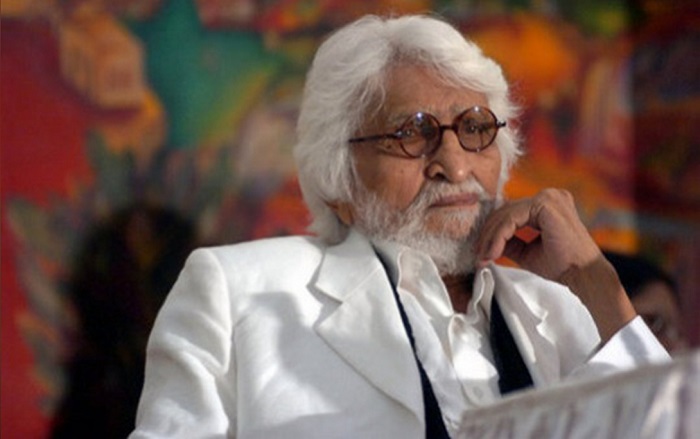M.F. Hussain

M.F. Husain was born on 17th September 1915 in Pandharpur town of Maharashtra into a Sulaymani Bohra family. Husain lost his mother when he was only one and a half years old. After a few months, his father remarried and moved to Indore, where Husain completed his schooling. For a few years during his teenage life, Husain stayed in Baroda, where he picked up the art of calligraphy. Thanks to his exposure to calligraphy, he gradually developed interest towards art and decided to become an artist. He moved to Bombay (now Mumbai) in 1935 and enrolled at the famous Sir J. J. School of Art.
Early Career
M. F. Husain started his painting career as a painter of cinema hoardings. By the early 1930s, Hindi cinema was flourishing with as many as 200 films per year and the advertising market was badly in need of high quality painters. Husain used this opportunity to take care of his daily needs. He also started working for a toy company, where he designed and made some innovative toys. He was also in touch with his mates from Sir J. J. School of Art and was waiting for the right opportunity to contribute towards the evolution of Indian art.
Formation of the Progressive Artists’ Group
M. F. Husain and his friends from Sir J. J. School of Art wanted to break the age-old tradition of the Bengal school of art. They knew that in order to take Indian art to the world stage, they had to encourage artists to embrace modernism. Husain saw the partition of 1947 as an opportunity to start a movement as many innocent lives were lost during the partition of Indian and Pakistan. Claiming that a ‘new India’ was born out of the partition, Husain and his friends urged their fellow artists to embrace new ideas and hence, The Progressive Artists’ Group, which they formed in 1947, became a force to reckon with. Soon, the movement gained recognition and the group grew in strength, which ultimately became a turning point in the history of Indian art.
Career & Controversies
Husain first exhibited his art works in Zurich in the year 1952 and then went on to display his works in the US for the first time in 1964. Though Husain enjoyed fame and respect during the initial phase of his career, a large portion of his painting career was mired in controversies. More often than not, various Hindu nationalist groups targeted him for hurting religious sentiments. In 1996, a Hindi monthly magazine named ‘Vichar Mimansa’ published some of his controversial paintings that were created in the 70s. The paintings that depicted nude Hindu goddesses earned the wrath of many Hindus and Hindu organizations and subsequently eight criminal complaints were lodged against Husain. Two years later, many of his paintings were vandalized and his house attacked.In 2006, he was charged again for hurting the sentiments of people for coming up with a nude portrait of Bharatmata (Mother India). The painting was forced to be withdrawn from various auctions and an apology from Husain was demanded. However, the painting was later sold at an auction for Rs 80 lakh. Eventually, Husain started receiving death threats from various powerful organizations and he was left with no other choice but to leave India.In 2008, one of his paintings was sold for a whopping $1.6 million at Christie’s, making him the best-paid painter in India at that time. Recently, a single canvas of M. F. Husain fetched over 2 million Dollars at a Christie’s auction. During his stay in Qatar, he was commissioned by Sheikha Mozah Bint Nasser Al Missned, Qatar’s first lady, to come up with two paintings – the history of Arab civilization and the history of Indian civilization. In 2008, he was commissioned to paint 32 paintings depicting the history of India. He could only complete eight, before his body gave up on this materialistic world.
Husain’s Stint with Movies
Hussain made his filmmaking debut in the year 1967, when he came up with ‘Through the Eyes of a Painter’. The film was showcased at the prestigious Berlin International Film Festival and also won the Golden Bear short film award.Husain was a great admirer of actress Madhuri Dixit and even considered her as his muse. In 1997, he made a cameo appearance in the film ‘Mohabbat’, which had Madhuri Dixit playing the female lead. Madhuri played an artist in the film and the art works displayed throughout the flick was contributed by Husain himself. In the year 2000, he made a film titled ‘Gaja Gamini’, which had Madhuri in the lead. The film spoke about womanhood and was intended to pay tribute to Madhuri Dixit.In 2004, he made a film titled ‘Meenaxi: A Tale of Three Cities’, which had actress Tabu in the lead. This film too, faced several controversies as some Muslim organizations claimed that one of the songs featured in the film was blasphemous in nature. The film was instantly pulled out of cinemas but went on to achieve critical success.
c@icaldrcsrc:culturalindia/rc




